Pump Handbook by Igor J. Karassik, Joseph P. Messina, Paul Cooper, Charles C. Heald - 3rd edition
Подождите немного. Документ загружается.

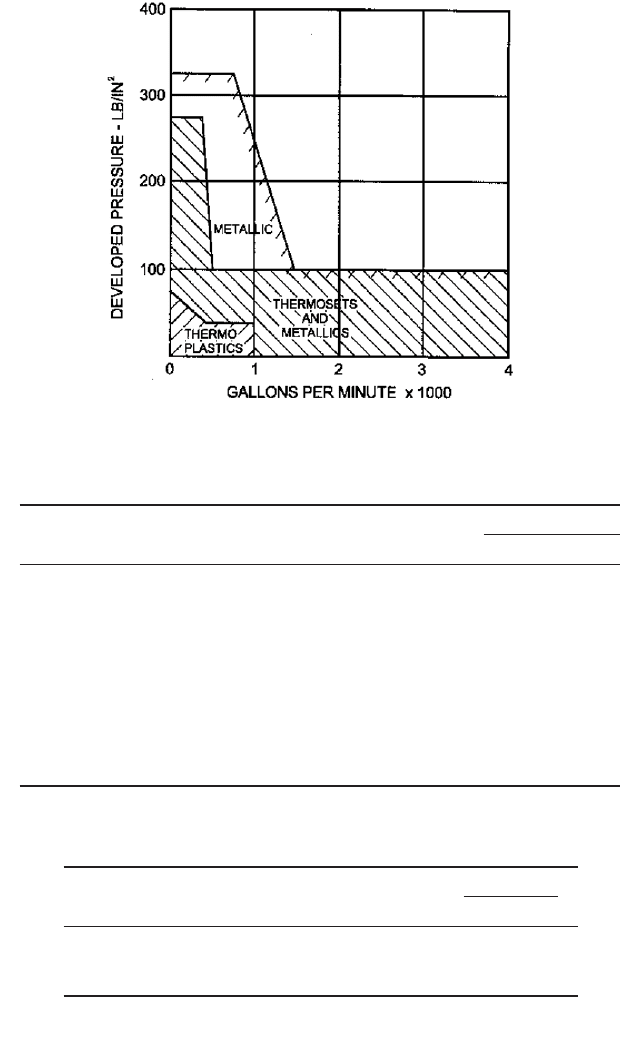
5.56 CHAPTER FIVE
FIGURE 2 Developed pressure versus flow for composite pumps (lb/in
2
0.0689 = bar; gpm 0.227 = m
3
/h)
TABLE 4 Thermoplastics used for pump parts
Temperature limit
Chemical name Common reference °F °C
Polycarbonate Lexon
®
250 120
Phenylene Oxide Noryl
®
194 90
Polyphenylene Ryton
®
-PPS 250 120
Polyphenylene PP 150–180 65–82
Chlorinated Polyvinyl Chloride CPVC 230 110
Polyvinylidene Chloride PVDC 160 70
Polyvinyl Chloride PVC 140 60
Polyetherether Keytone PEEK 250 120
Polytetrafluoroethylene Teflon
®
-PTFE 460 238
Chlorotrifluoroethylene Teflon
®
500 260
Polyvinylidenefluoride Kynar
®
-PVDF 300 150
TABLE 5 Thermostats used for pump parts
Temperature
Name Common Reference °F °C
Vinyl Ester GL VE-Gl 250 120
Vinyl Ester C VE-C 250 120
Epoxy Epoxy 250 120
GL
—
glass reinforced (should not be applied to hydrochloric acid or caustics)
C
—
carbon reinforced
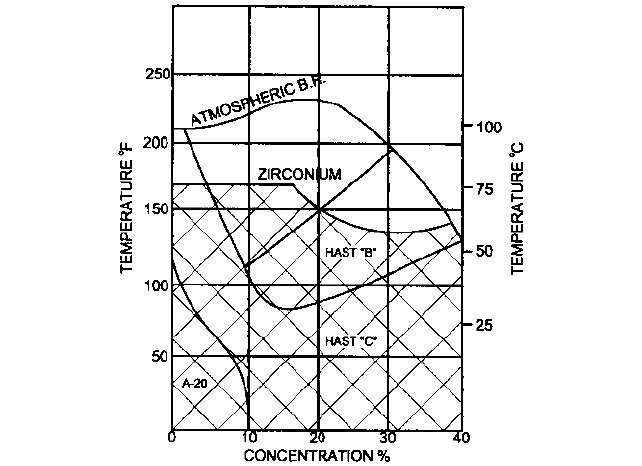
5.2 MATERIALS OF CONSTRUCTION FOR NONMETALLIC (COMPOSITE) PUMPS 5.57
FIGURE 3 Material selection for hydrochloric acid
• Sulfuric acid diluted up to 70%
• Hydrochloric acid
• Sodium hydrochloride
• Nitric acid up to 5%
Figure 3 shows that a composite pump can handle up to a 40% concentration of
hydrochloric acid at 175°F (80°C).
Sulfuric Acid Figure 4 shows the operating range of a composite pump, pumping sul-
furic acid.
Ferrous and Ferric Chloride Ferric chloride is used as an etching reagent in the pro-
duction of printed circuit boards. It is also used as a coagulant in wastewater treatment.
In metal pickling operations, ferric is produced when hydrochloric acid reacts with iron
and steel. In all of these applications, composite pumps have replaced the more costly tita-
nium pumps.
Ethylene and Propylene Candidate applications for composites of ethylene and propy-
lene are
• Propylene glycol
• Ethylene glycol
• Diethylene glycol
• Proplene chlorhydrin
Dyes Acid, sulfur, and Diazo dyes can be used in composite pumps.
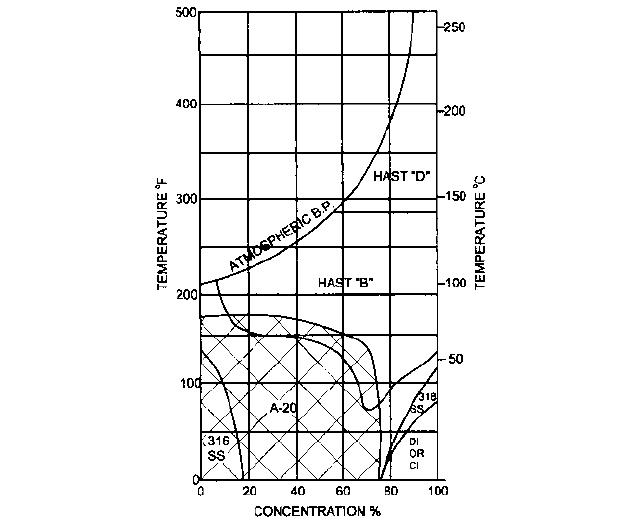
5.58 CHAPTER FIVE
FIGURE 4 Material selection for sulfuric acid
Agriculture Chemicals Pesticides comprised of insecticides, herbicides, fungicides, and
fertilizers can be severely corrosive to a composite pump.The chemical supplier should be
contacted for their recommendations of materials suitable for use with their products.
Table 6 lists the maximum temperature and concentration of several liquids for vari-
ous polymers.
INDUSTRIES USING COMPOSITE PUMPS ________________________________
Pulp and Paper
Composite pumps are used in bleaching and cooling of liquor prepa-
ration. The pumps can handle white, black, and green liquors. Other liquids suitable for
composite pumps associated with this industry include
• Sulfuric acid
• Sodium chlorate
• Sodium hypochlorite
• Sulfur dioxide
• Chlorine
• Methanol
• Peroxide bleach
• Sodium chloride
• Chlorine dioxide

5.59
TABLE 6 Maximum temperatures of polymers in various liquids
Vinyl
Type Fluid Symbol Concentration Ester CPVC PVC PVDF PTFE ECTFE PPS Polypropylene Epoxy PEEK
Acids Hydrochloric HCl 37 100 185 70 275 260 200 200 70 140 250
Acid (38) (85) (21) (135) (127) (93) (93) (21) (60) (121)
Sulfuric Acid H
2
SO
4
75 120 140 70 200 500 300 80 125 NR NR
(49) (60) (21) (93) (260) (150) (27) (52)
Nitric Acid HNO
3
20 150 185 140 140 250 200 150 140 70 NR
(65) (85) (60) (60) (121) (93) (65) (60) (21)
Alkalies Potassium KOH 45 100 200 185 165 300 250 200 185 185 150
(Caustics) Hydroxide (38) (93) (85) (74) (150) (121) (93) (85) (85) (65)
Sodium NaOH 50 210 200 NR 200 300 200 160 185 70 150
Hydroxide (100) (93) (93) (150) (93) (71) (85) (21) (65)
Ammonium NH
3
OH 20 100 200 150 275 300 200 200 225 100 250
Hydroxide (38) (93) (65) (135) (150) (93) (93) (107) (38) (121)
Sodium NaCl Sat’d. 210 200 150 275 400 70 200 225 210 250
Chloride (100) (93) (65) (135) (204) (21) (93) (107) (100) (121)
Oxidizers Sodium NaOCl 10 180 200 100 100 300 200 200 140 NR 250
Hypochlorite (82) (93) (38) (38) (150) (93) (93) (60) (121)
Hydrogen H
2
O
2
30 150 140 70 240 480 140 150 70 70 250
Peroxide (65) (60) (21) (115) (250) (60) (65) (21) (21) (121)
Organics Benzene C
6
H
6
100 100 NR NR 125 390 200 200 NR NR 250
(Solvents) (38) (52) (200) (93) (93) (121)
Styrene CH
5
CH:CH
2
100 120 NR NR ND 200 ND 120 NR 140 250
(49) (93) (49) (60) (121)
Ethyl Alcohol C
2
H
5
OH 95 100 140 70 210 390 300 200 140 70 250
(38) (60) (21) (100) (200) (150) (93) (60) (21) (121)
Corrosion resistance of common polymers in difficult process fluids. Max. recommended temperature
—
deg. F (deg. C)
NR Not Recommended
ND No Data Available
5.60 CHAPTER FIVE
• Sodium hydroxide
• Hydrochloric acid
Metal Finishing Composite pumps are an excellent choice for use in this industry for
two reasons:
• The chemicals used in electroplating, steel pickling, etching, anodizing, galvanizing, and
plating do not chemically attack composites.
• Metal pumps can generate stray currents and could effect the plating process.
Composite pumps are natural electrical insulators, which makes them well suited for
this industry.
Desalinization and Water Purification Composites can replace 316 stainless steel,
duplex stainless steel and Alloy 20 on sea water distillation plants. On reverse osmosis
equipment, composite pumps can be used for backwash, membrane blowdown, and intake
screen wash.
Aqua Culture Composite pumps can be used for waste removal, seawater transfer,
washdown, and filtering without adversely affecting sea life. This adverse reaction can
occur with metal pumps. Metal pumps can have a chemical reaction with seawater and
stray electrical currents generated by the pump can affect the pump’s mechanical seal.
STANDARDS FOR COMPOSITE PUMPS__________________________________
There are many composite pump designs for low-pressure and low-capacity use in the
general-purpose market. For composite pumps in the “industrial chemical market,” how-
ever, a separate standard ANSI/ASME B 73.5M has been written. This standard is simi-
lar to B73.1M for metal pumps in that it requires the same dimensional
interchangeability, shaft deflection, and seal chamber requirements. The composite pump
standard differs from the metallic pump standard in these areas:
• Basic working pressure is from 100 to 275 lb/in
2
(6.9 to 19 bar) depending on pump size.
• Nozzle flanges are Class 150 dimensions but not Class 150 rated.
• Hydrostatic pressure factor above working pressure will depend on size, rpm, and man-
ufacturing process.
• Pressure-temperature limit will be based on a manufacturer-user agreement for the liq-
uid and its concentration.
• The standard applies to both thermoplastic and thermoset composites.
• Casing, casing cover, and gland have a minimum corrosion allowance of two years.
Hydraulic Institute Material Selection Guide A material selection guide has been
written with recommendations of what composite should be used with what type of liq-
uid. This guide lists 150 liquids at various concentrations and temperatures and recom-
mends suitable compostites for applications. See References and Further Reading at the
end of this section.
PUMP CONSTRUCTION _______________________________________________
The pump section views in Figures 5 to 8 illustrate the construction of some composite
pumps.
Components Figure 9 shows various pump components made from both thermoplas-
tic and thermoset polymers. The enclosed impellers are made of thermoplastic resins
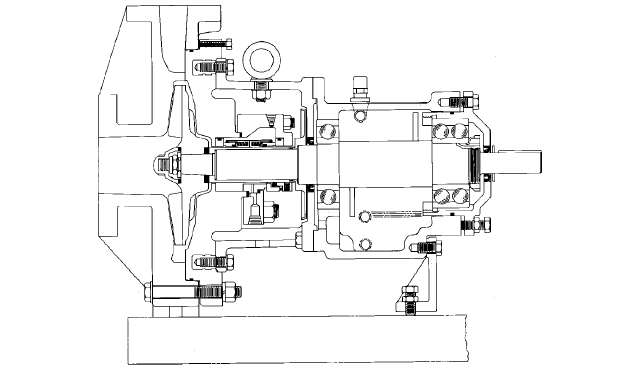
5.2 MATERIALS OF CONSTRUCTION FOR NONMETALLIC (COMPOSITE) PUMPS 5.61
FIGURE 5 ANSI/ASME B73.5M pump (Flowserve Corporation)
because the front and back shroud can be ultrasonic- or vibration-welded together. Semi-
open impellers can be made of either type of composite. On sizes greater than 6 in (152
mm) diameter, thermosets are usually used due to their superior strength over thermo-
plastics. When thermoplastics are used in larger impellers, a metal reinforcing skeleton
is used for reinforcement. Casing and casing covers are made of either composite depend-
ing on the pump size and pressure rating.
The seal between the casing and cover is usually a shaped “O-ring” held by a groove
running around the perimeter of the casing. The “O-ring” is compressed between the cas-
ing and cover with a ring of bolts around the casing’s perimeter.
Shafts are made of AISI 4140 or 316 stainless steel with a thermoplastic shaft sleeve
for corrosion protection. Mechanical seals are of “outside” construction to prevent liquid
from contacting the metal portion (springs) of the seal.
Bedplates Composite materials have several advantages over metals and other mate-
rials when used for bedplates. Composites do not rust, rot, or deteriorate in adverse envi-
ronments. The composite bedplate maintains its shape over time. This assures that the
pump shafts will stay in alignment, and the pump’s nozzle will not be stressed due to a
sagging bedplate. The designed in features in a composite bedplate include an integral
drip lip, slopping surface to collect drips, and ringed grout holes.
Disclaimer The data and notes included in this section are only for general guidance.
No recommendations are intended as a guarantee by the author or other sources. Pump
manufacturers and material suppliers can supply specific application information for their
products when used with specific liquids in identified services and environments.
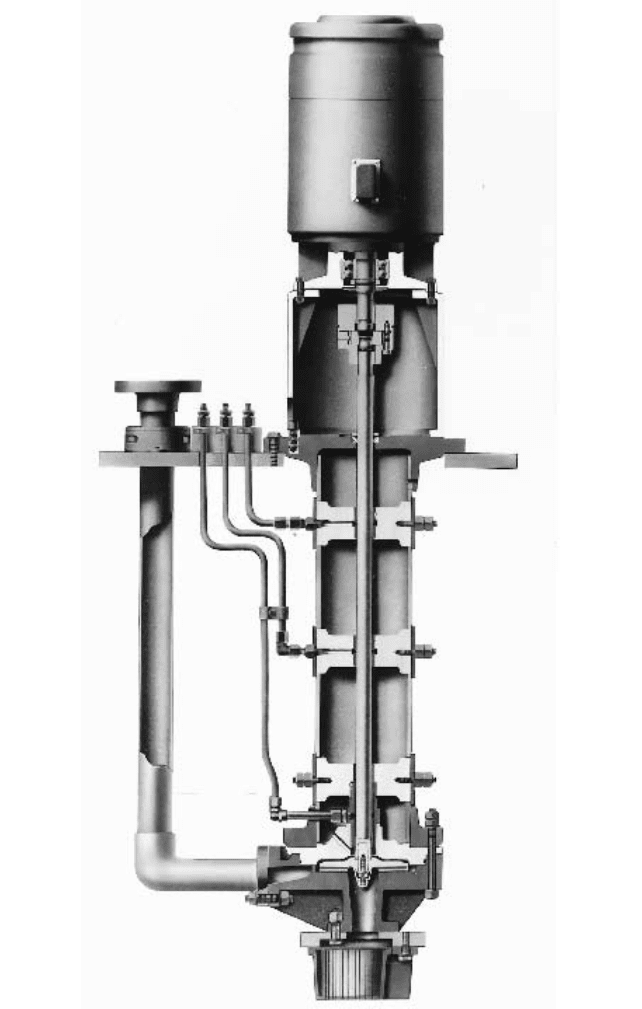
5.62 CHAPTER FIVE
FIGURE 6 Vertical immersion pump (Flowserve Corporation)
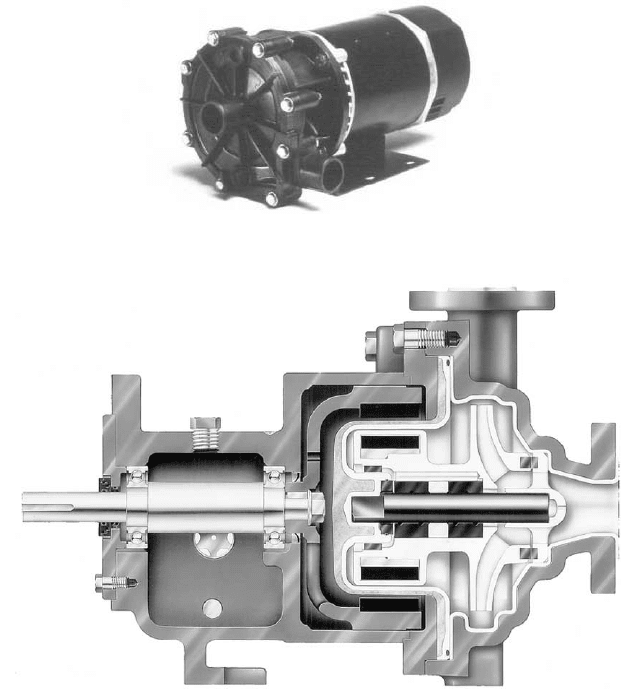
5.2 MATERIALS OF CONSTRUCTION FOR NONMETALLIC (COMPOSITE) PUMPS 5.63
FIGURE 7 Thermoplastic coolant pump (Flowserve Corporation)
FIGURE 8 Fluoropolymer sprayed lined ANSI/ASME B73.3 pump (Goulds Pumps)

5.64 CHAPTER FIVE
FIGURE 9 Components made of thermoset (Flowserve Corporation)
REFERENCES AND FURTHER READING_________________________________
American Society of Mechanical Engineers. “Specification for Thermoplastic and Ther-
moset Polymer Material Horizontal End Suction Centrifugal Pumps for Chemical
Process.” ASME B73.5M-1995, New York.
American National Standard for Pumps
—
General Guidelines for Types, Definitions,
Application, Sound Measurement, and Decontamination, ANSI/HI 9.1-9.5-2000, Section
9.3.3, Common Polymer Materials of Construction for Various Liquids, Hydraulic Insti-
tute, Parsippany, NJ www.pumps. org.
Besic, D. “Spotlight on Plastics.” Pump and Systems Magazine, October 1994, Fort Collins,
CO.
Buse, F. W. “Tutorial on Composite Pumps.” Proceedings of the 11th International Pump
Users Symposium. March, 1994, Texas A&M University, College Station, TX.
Fusco, J. “Plastic Developments Advance Pipe Performance and Safety.” Chemical Pro-
cessing, December 1990.
Henning Kausch, H. “Advanced Thermoplastic Composites.” Hanser Gardner Publications,
6915 Valley Ave., Cincinnati, OH, 1992.
Lin, S., and Pearce, E. M. “High Performance Thermosets,” Hanser Gardner Publications,
6915 Valley Ave., Cincinnati, OH, 1993.
Margus, E.“Choosing Thermoplastics Pumps.” Chemical Engineering, July 1991, McGraw-
Hill, New York.
Modern Plastics Encyclopedia ‘99. The McGraw-Hill Companies, Inc., Highstown, NJ, 1998.
Plastics Technology Manufacturing Handbook. Bill Communicators Inc., 355 Park Ave.,
South New York, NY, 1998.
Rosato, D. V., DiMattia, D. P. “Designing with Plastics and Composites
—
A Handbook.” Van
Nostrand Reinhold, New York, 1991.
Internet Resources
Injection Molding Magazine’s listing of books: http://www.immbookclub.com
Plastic technology consulting source: http://www.rapra.net/intro.htm
Listing of plastic resources and issues: http://www.polysort.com
5.2 MATERIALS OF CONSTRUCTION FOR NONMETALLIC (COMPOSITE) PUMPS 5.65
